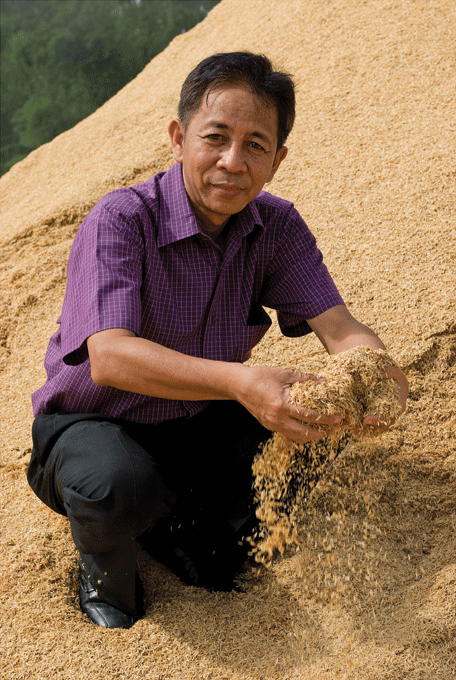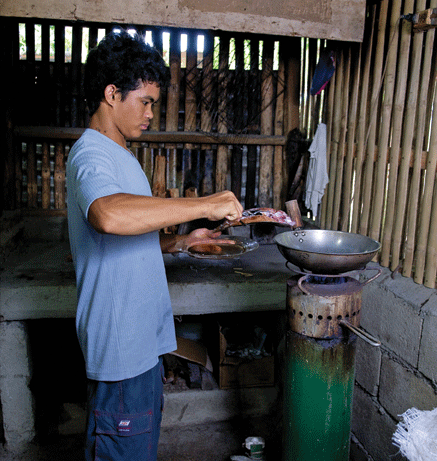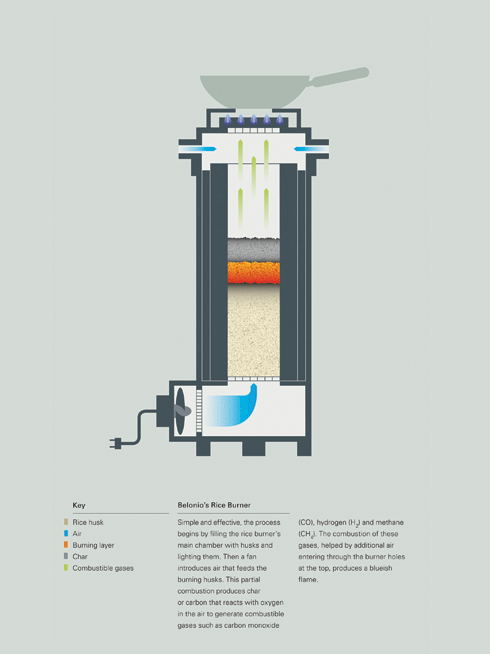
|
Published:
Sound and rice power to cut black carbon
The mating of two brilliant ideas, a low-tech one from the Philippines and a hi-tech one from the US, offers a new route to help cool the planet – fast. Julian Cribb reports.
‘Black carbon’, the soot from billions of domestic fires across the poorer regions of the world, is a powerful, but little-publicised driver of climate change. Scientists now consider it provides around half the global warming potential of carbon dioxide.
In a unique marriage of high and low technologies, Philippino engineer Alexis Belonio and US physicist Steve Garrett have come up with a way to improve the health of poor people, beat a major global waste problem and develop a fast-track technology to counter global warming.
Belonio is the inventor of the world’s most efficient gas cooker fuelled by waste rice husks; Garrett the genius behind the world’s first truly clean refrigerator, which is cooled using sound waves.
Between them, they have hatched an idea that could see the Third World outstrip developed nations in the race to devise rapid solutions to global warming.
‘Black carbon – which is basically the soot from billions of domestic cooking fires – is about 600 or 700 times more potent than CO2 as a climate warmer; it absorbs more heat because it is black,’ Garrett says.
‘But it only lasts about 10 days in the atmosphere, so this is a problem you can actually fix quite quickly – as opposed to CO2, which hangs around for centuries.’
If the smoky cooking fires of the developing world could be replaced with low-cost stoves like Belonio’s, which converts biomass to a clean gas, it could start to cut humanity’s carbon emissions within days. Developing countries would become world leaders in combating climate change.
Belonio’s stove is fuelled by unwanted waste – such as the 150 million tonnes of husks discarded in rice-growing regions each year. The US$20 cooker turns this free, low-energy fuel into a greenhouse-neutral gas that burns with a clear blue flame. This can save a poor family up to one-tenth of their income every year, as they no longer need to buy gas or kerosene for cooking.

|
|
The inventor of the rice-husk fuelled stove, Alexis Belonio, has made his design readily available over the internet. Credit: Kirsten Holst/Rolex
|
Because it burns cleanly, the stove is much healthier to use: the World Health Organization estimates that indoor air pollution caused by smoky fires kills about 1.6 million women and children every year.
Key to the efficiency of the stove is a small electric fan that drives a stream of air through the smouldering rice husks. This produces the gas mixture which the stove then burns, just like a normal gas cooker.
The catch is that you need electricity to drive the fan – and half the developing world still lacks this essential energy source.
Enter Steve Garrett of the Pennsylvania State University, a specialist in the science of thermoacoustics who had been working as Scientific Adviser to the US State Department’s South-East Asia bureau.
‘We were looking for technologies that would assist development, clean up the environment, address global warming and improve health,’ says Garrett.
‘Take a look on the internet at the dark areas of the planet at night. These are the places where there is no electricity, where people burn biomass to cook or warm their homes. That is where most of the black carbon comes from.
‘In Asia, unlike the developed world, one half of the global warming potential is due to black carbon and other products of incomplete combustion such as methane, carbon monoxide and ozone precursors.’
Like Belonio, the American physicist is a Laureate of the Rolex Awards for Enterprise. Garrett, who became a Laureate in 1993, learned of Belonio’s work when the latter won his award in 2008.
The winner of several other major prizes for environmental technology and the holder of over 20 patents, Garrett has developed sound-driven refrigerators – used by the US space program and US Navy – with a view to one day replacing the billions of ‘dirty’ refrigerators and air conditioners worldwide that use either ozone-destroying CFCs or planet-warming HCFCs as coolants. Garrett’s refrigerators, chillers and freezers use electricity to make high-intensity sound waves to compress a clean, inert gas, initiating the cooling cycle used in refrigeration.
Belonio has made his stove design available, free, to more than 40 companies, non-governmental organisations, aid agencies and local groups in a dozen countries. He is currently working with Minang Jordanindo Approtech in Indonesia, which is making 80 stoves a week, and plans to assist similar operations in Vietnam and Cambodia, in addition to his native Philippines. Inquiries are pouring in from countries such as India and China, as well as South-East Asia.
In Belonio’s latest model stove, a container of rice husks is loaded into the stove and burned until used up, then exchanged for another – like swapping the bottles on a gas barbecue. The ash from the burned husks can be mixed into the soil, where its ability to hold moisture results in crop yields is 10 to 20 per cent higher.

|
|
Belonio’s rice husk gas stove releases no toxic gases or fumes; the rice husk is a cheaper fuel source than kerosene or LPG. Credit: Kirsten Holst
|
The aim is to make the rice cooker available in towns and villages where rice is not produced locally. This will create jobs for workers in rice-growing areas, who will gather the unwanted rice husks and pack them into fuel containers.
Garrett has used his expertise to find a way of converting heat from the stove to sound, and sound to electricity for running the fan – in essence reversing the process used in his acoustically-powered fridge. This means the stove could be used anywhere with a suitable biomass fuel supply, and act as its own electrical power source.
‘All you need is 2–3 watts to run the stove’s fan and a few watts more to run other devices,’ Garrett says. ‘We would like to use the stove’s heat to generate sound waves and use that sound in a linear alternator – a sort of highly efficient microphone – to make electricity.
‘It is a big deal using a simple stove to put electricity into people’s lives in areas that may never be on the grid. They can also use it to charge a battery to light their home, or to power a cell phone.’
Belonio is apprehensive about the possible cost of the upgraded stove. He has struggled for years to design a cheap, practical design that can be made in an ordinary village workshop from scrap metal and is affordable to the poorest of the poor. He has got the price down to $20-$25 a unit, and is worried about the added cost that a high-tech power source might involve.
However, Garrett believes it is possible for the stove to produce electricity thermoacoustically with inexpensive components. If such a design could be shown to work successfully and also fix the black carbon problem, governments and aid agencies might provide funding to make the stove affordable for worldwide distribution, possibly offsetting part of the additional cost with carbon credits.
Garrett does not underestimate the task ahead. ‘We have to get this technology out to 3 billion people who are burning biomass, more than half of whom have no access to electricity. The challenges of low-cost manufacturing, distribution, adoption, and marketing seem more daunting to me than the technological challenges.’
He is already drawing up a technology roadmap to persuade governments to get behind the plan to put clean, self-powered, fuel-efficient stoves into hundreds of millions of homes.




